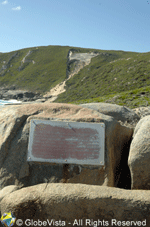The Natural Bridge in Albany, Western Australia is one of the Rainbow Coast’s most extraordinary natural features, along with The Gap.

The Natural Bridge was formed thanks to the gradual wearing away of the rock by the Great Southern Ocean and her powerful waves.
During heavy swells don’t be surprised if you get covered in water spray when the large waves coming crashing in.
It is very tempting to ignore all the warning signs and take a walk along the granite arch but be warned the area is notorious for unexpected “freak” waves. Many an unsuspecting soul has been washed off these rocks.

Background to The Natural Bridge – For over one billion years Australia and Antarctica were actually joined together, forming part of a supercontinent called Gondwana.
The ancient continent was formed mainly of gneiss, a rock created deep in the Earth’s crust. At some stage pressure and friction at the base of these two fused continents caused rocks to melt and slowly rise up through the gneiss. As the molten rock rose it also slowly cooled and turned into granite, which helped to cement the continents together.
Over the course of millions of years, sections of the Gondwana continent began breaking apart. The final separation between Antarctica and Australia happened around about 45 million years ago. The massive rock formations that you will see at the Natural Bridge and The Gap are what was left behind following the split.
Interestingly, the rock formations on Australia’s Southern Coast can still be matched to identical rocks off the Northern coast of Antarctica near Windmill Islands.
How was the Natural Bridge Formed? – Remember how I was saying that pressure and friction at the base of the continents caused the rocks to melt, and as they rose and slowly cooled they turned into granite? Well, that granite lay about 20km below the surface. Above it was softer rock that over time eroded away, thanks to wind and water, allowing the granite to slowly rise above the surface. As the granite rose it also expanded and cracked. The wind, waves, water and air pressure slowly wore away at the cracks sculpting them into block-shaped sections. The relentless pounding of the waves eventually tore away any loose blocks of granite creating amazing structures like the Natural Bridge and The Gap.
Eventually, over time these structures will widen and collapse and new Gaps and Natural Bridges will take their place.
The Amazing Rescue of Stephen Matthews in 1978
 When you are wandering through the path between The Gap and the Natural Bridge you will more than likely come across a plaque dedicated to the heroes who helped in the amazing rescue of tourist Stephen Matthews.
When you are wandering through the path between The Gap and the Natural Bridge you will more than likely come across a plaque dedicated to the heroes who helped in the amazing rescue of tourist Stephen Matthews.
The Story – On March the 14th, 1978, 20 year old tourist Stephen Matthews was taking photos at the “Natural Bridge” off the coast of Albany when a king wave hit. While everyone scrambled for safety Stephen was caught by the wave, thanks in part to his thongs (flip flops). The retreating water pulled him down the slope, on his butt and into the churning sea below. Horrified tourists could only watch in horror as the sea dragged him under then spat him out, away from the cliffs. The chances of him surviving in the water on the rugged and unforgiving coastline were slim.
By the time word got back to authorities, light was quickly fading. Police contacted the whaling station requesting any vessels or planes to help assist in the rescue. The whale chaser Cheynes II, skippered by Paddy Hart, and a spotter plane piloted by John Bell offered their services.
Matthews, in the meantime, had managed to float out of direct danger of the waves crashing against the cliffs but was still being thrown around by the growing swell.
As darkness descended the plane circled low over the area, acting as a light source for the crew of Cheynes who were struggling in the massive swell. Colin Westerberg was the first to spot the dark figure of Matthews, bobbing in the ocean. The skipper of the Cheynes II turned the engine off , despite being so close to the rocks, so that they could hear him. When they were close enough to Matthews, the first mate Keith Richardson dived into the ocean and dragged the poor soul aboard the whaling ship.
This would be the first recorded survival of someone having been swept into the sea at The Gap and Natural Bridge.
Following a short stay at Albany Hospital, Matthews worked on the whale chasers for a few months before continuing his travels. Before he left, the Shire and Town of Albany held a reception for him and all the brave men and women who helped in the rescue.
References: The full account of the rescue can be found in the book The Last Whale by Chris Pash.
How to Get There – The Natural Bridge and The Gap are located off Frenchman Bay Road, in Torndirrup National Park, Albany. The entrance is clearly marked but if you drive too fast you will miss it. The area is a 15 minute drive from Albany across Princess Royal Harbour.
